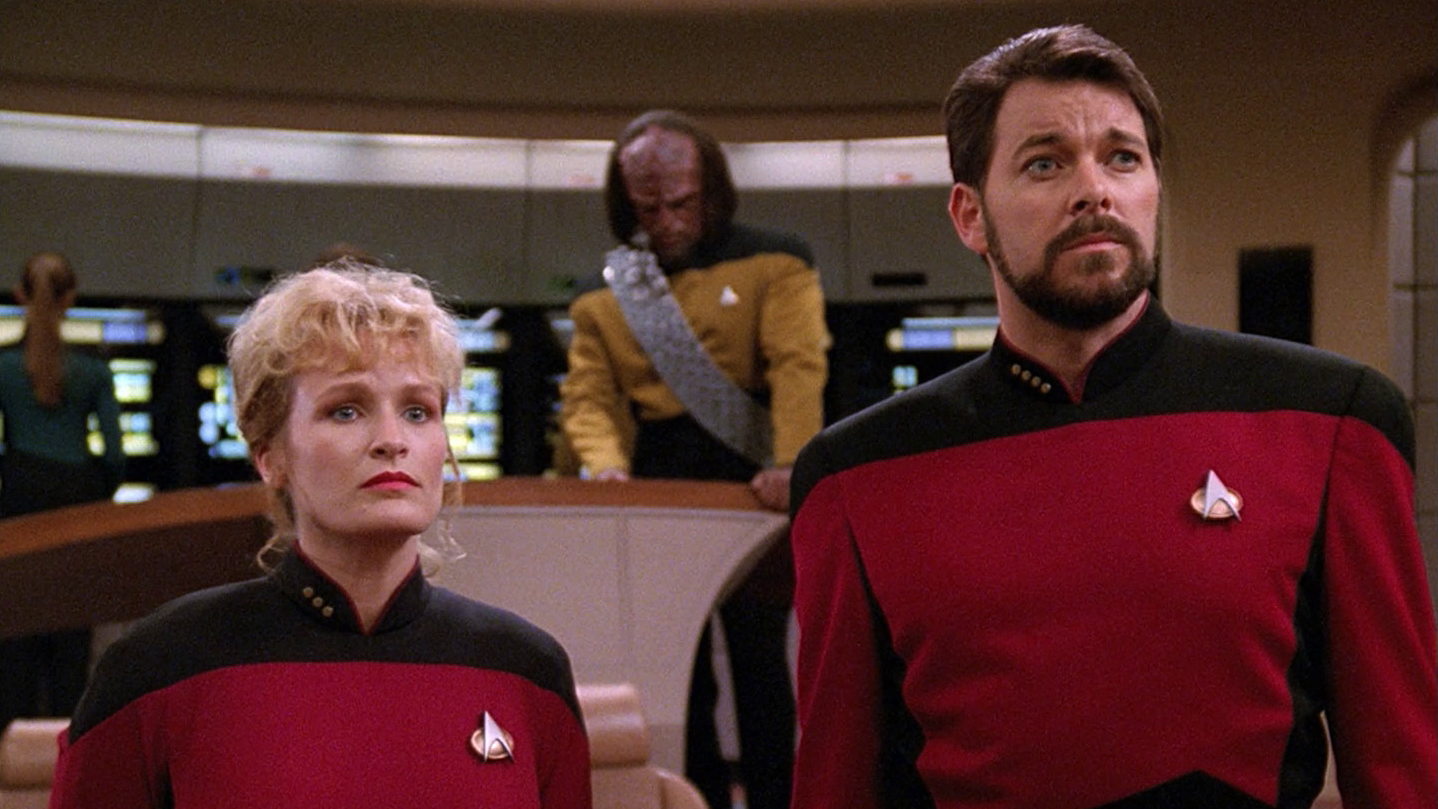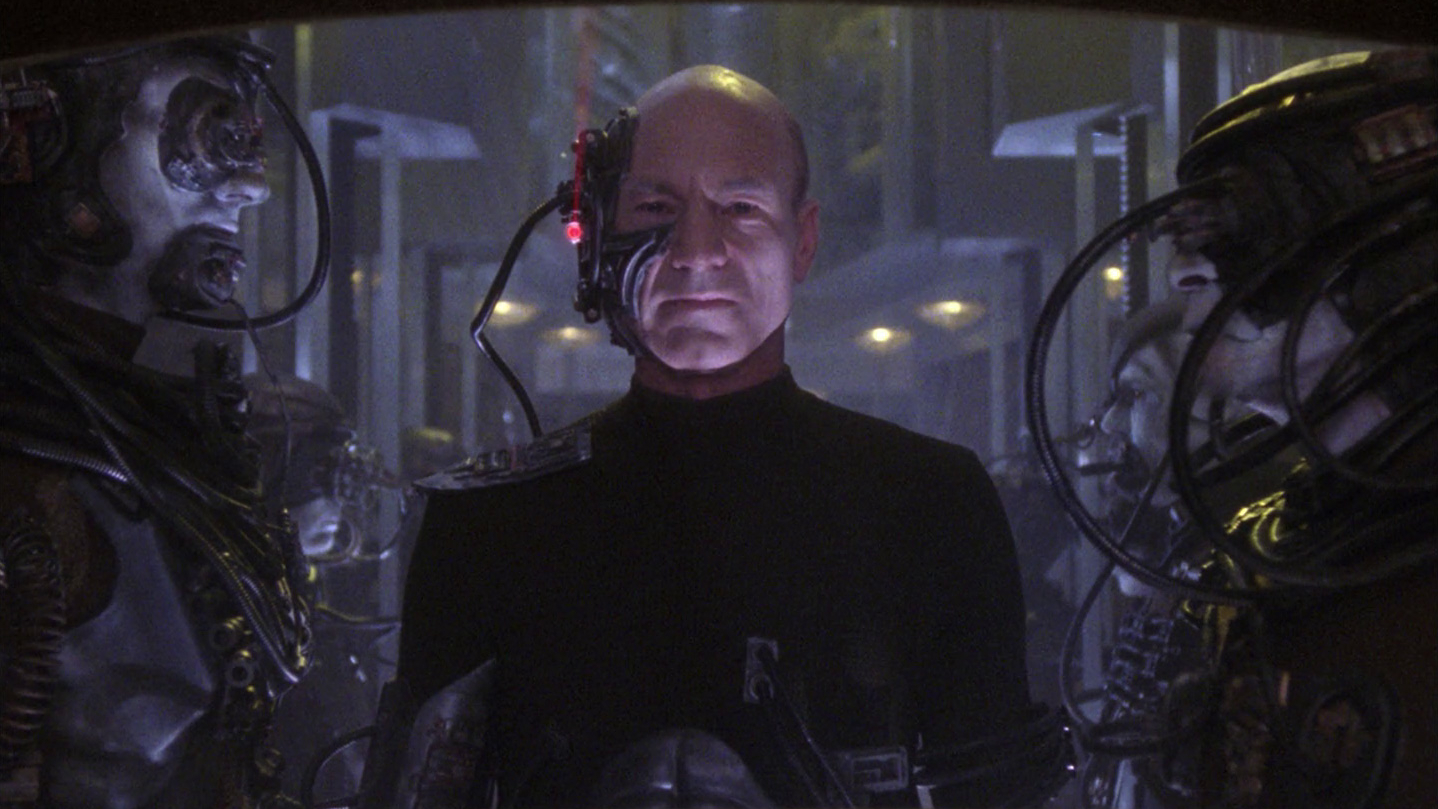'The Best of Both Worlds' at 35: Why we're still assimilated by 'Star Trek''s greatest ever cliffhanger
Resistance is futile! We look back on the classic 'Trek' episode, back when the Borg were still the scariest bad guys in the galaxy.

Okay, it wasn't quite the three years "Star Wars" fans had to endure waiting for closure on that "I am your father" revelation. Even so, the summer of 1990 can't have been easy for "Star Trek" fans who'd just watched "The Best of Both Worlds", "The Next Generation"'s season 3 finale. The classic episode debuted 35 years ago this week, and remains the franchise's greatest ever cliffhanger.
The Borg's arrival in the Alpha Quadrant came as little surprise, of course. The assimilation-happy cyborgs had been (vaguely) teased as far back as the season 1 closer "The Neutral Zone". Then Captain Picard and co had their first close encounter with one of those distinctive Cube spaceships in season 2's "Q Who", after cosmic prankster Q zapped the Enterprise 7,000 light years across the galaxy, essentially to prove a point — namely that, despite Picard's ready-for-anything hubris, some very bad things were waiting for them on the final frontier.
Indeed, the Borg — who were, early in their development, conceived as space-faring insects — were perfectly designed to fill a vacuum in a show still looking for an iconic villain. (The aggressively capitalist, but not very scary, Ferengi did not last long as "TNG"'s Big Bads.) "The Best of Both Worlds" was the story this malevolent hive mind could sink its cybernetically enhanced teeth into — and despite making numerous comebacks over the last three decades, they've never felt as threatening since.

The premise of the story is simple. A single Borg Cube — identical to the one the Enterprise faced at System J25 in "Q Who" — arrives, uninvited, in Federation space. After working their way through their now-familiar boilerplate warnings about resistance being futile and adding your "biological and technological distinctiveness" to their own, the Borg make an unexpected departure from the script. They want to appoint none other than Jean-Luc Picard as their spokesperson as they embark on the assimilation of the Federation.
Of course, the strategy makes little logical sense — the Borg are so powerful that, in their own words, "Negotiation is irrelevant" — but Picard's Borgification is utterly perfect for the drama. It also gives a human face to an antagonist that, by definition, has no leader, a concept that would be revisited with the introduction of the previously unmentioned Borg Queen in 1996 movie "First Contact". (It's interesting to note that several members of the "TNG" production team were sceptical about the Borg's lack of personality — executive producer Rick Berman has described them as "two-dimensional". For our money, though, their quest for uniformity is exactly what makes them such a unique and memorable villain.)
In the tradition of the very best "Trek", "The Best of Both Worlds" has much more to say about the crew of the Enterprise than the alien invaders on their viewscreen. For example, while franchise highpoint "The Wrath of Khan" is fundamentally a tale of revenge, its themes of ageing and negotiating the hypothetical no-win scenario are just as integral to the mix. In the same way, "The Best of Both Worlds" is an opportunity to put Commander William Riker in the spotlight.

At the start of the episode, he's turned down a third opportunity to command his own ship (the USS Melbourne, in case you're wondering) in favour of extending his stay on the Enterprise. This causes him to wonder whether, after a career of non-stop progression, he's started to stand still — especially when uber-ambitious Borg expert Lt Cmdr Shelby starts sniffing around his job. Picard's unexpected departure inadvertently plunges Riker into the ultimate job interview, a Kobayashi Maru test in all but name.
Breaking space news, the latest updates on rocket launches, skywatching events and more!
Riker's arc was built from real-world inspiration. Showrunner Michael Piller, the man widely credited with getting "The Next Generation" on track after two patchy seasons, was also getting itchy feet, eager to write movies and create TV shows of his own.
"I had always told myself that I wouldn't commit long-term to anything," Piller said in "The Fifty-Year Mission: The Next 25 Years" by Mark A Altman and Edward Gross. "But as I was sitting writing this script, I found myself in the position of Riker, who was trying to decide whether he was going to leave the ship or not. Much of what happened to him in 'part one' was about what was going on in my head. He comes to the realisation that ambition isn't everything. If you're happy and comfortable and find the rewards in the people you work with, that's something that counts for a great deal."
Like Riker, Piller opted to stick around. There remained, however, a question mark over the future of leading man Patrick Stewart, who'd told show bosses he was "bored" in the role. Even Stewart's co-stars were uncertain whether he'd still be making it so in season 4, adding extra edge to a cliffhanger in which the Enterprise crew stand ready to unleash their most powerful weapon on their captain, now forcibly rebranded as Locutus of Borg.

At this stage, even Piller was unsure what was going to happen after the "to be continued" fade out, later admitting, "I never try to think of these things until I have to". Once he'd signed up for another year at the helm, the showrunner — with a bit of help from Berman — worked out how to wrap up the story.
In the tradition of most TV two-parters, the resolution — the imaginatively titled "The Best of Both Worlds: Part II", broadcast three months later — couldn't quite live up to the first half of the story. That said, the episode features some truly memorable moments: the Enterprise traversing the starship graveyard the Borg have left behind at Wolf 359 is eerie and poignant, especially when Riker spots the wreckage of the Melbourne. Meanwhile, Data and Worf's daring mission to recover Picard/Locutus from the Cube is later described by the deBorged Picard as "a brilliantly unorthodox strategy from a former first officer of mine".
The Enterprise's solution to their Collective problem turns out to be spectacularly low-key, effectively based around putting the Borg to sleep. Watching now, in this era of mega-budget sci-fi spectacle, it has the slight whiff of anti-climax, but it's also totally appropriate for a two-parter that creates the illusion of scale without going overboard on phasers and photon torpedoes. Sure, it's one of the more action-heavy episodes of "TNG" — we're even treated to a rare separation of the Enterprise's saucer and drive sections — but you imagine you've seen a lot more than you actually have.

The story's famous cliffhanger ultimately turned out to be just as transformative as Picard's time on board the Borg vessel. The only previous two-parter in "Trek" history had been the Original Series' "The Menagerie", but after "The Best of Both Worlds" they became standard issue in "The Next Generation", and subsequently "Deep Space Nine" and (particularly) "Voyager". The story's legacy is still being felt today, with "Strange New Worlds"' "Hegemony" (a two-parter straddling season 2 and the upcoming season 3) making little effort to hide its aspirations to be a "The Best of Both Worlds" for the 21st century.
Despite only appearing in these two episodes of "The Next Generation", the fan-favourite Elizabeth Shelby proves such an effective foil for Riker that she was considered worthy of a return in both "Lower Decks" and "Picard"'s brilliant final season.
Alas, time has been less kind to the Borg, who've now been defeated too many times – particularly at the hands of the marooned USS Voyager crew — to terrify the Federation as they once did. Episodes showing other facets of the Collective (such as "I Borg", in which a drone learns the concept of individuality) have been most successful, while "First Contact" is up there with the best "Star Trek" movies. But a combination of too many retcons (the Borg Queen, nanoprobes, drones turning up in prequel series "Enterprise") and plain old diminishing returns have left them a shadow of their former selves.
They were last sighted in "Star Trek: Picard", in a story that — for now, at least — appears to have put a full stop on their bid for galactic domination. But antagonists as iconic as the Borg don't tend to stay dead forever, so it's unlikely we've seen the last of the Collective. In the meantime, we still have "The Best of Both Worlds", a reminder of a time when resistance really was futile.
'Star Trek: The Next Generation' is available on Paramount+ in the US, and Paramount+ and Netflix in the UK. On the new series front, 'Star Trek: Strange New Worlds' season 3 launches on Paramount+ on Thursday, July 17.

Richard's love affair with outer space started when he saw the original "Star Wars" on TV aged four, and he spent much of the ’90s watching "Star Trek”, "Babylon 5” and “The X-Files" with his mum. After studying physics at university, he became a journalist, swapped science fact for science fiction, and hit the jackpot when he joined the team at SFX, the UK's biggest sci-fi and fantasy magazine. He liked it so much he stayed there for 12 years, four of them as editor.
He's since gone freelance and passes his time writing about "Star Wars", "Star Trek" and superheroes for the likes of SFX, Total Film, TechRadar and GamesRadar+. He has met five Doctors, two Starfleet captains and one Luke Skywalker, and once sat in the cockpit of "Red Dwarf"'s Starbug.
You must confirm your public display name before commenting
Please logout and then login again, you will then be prompted to enter your display name.
